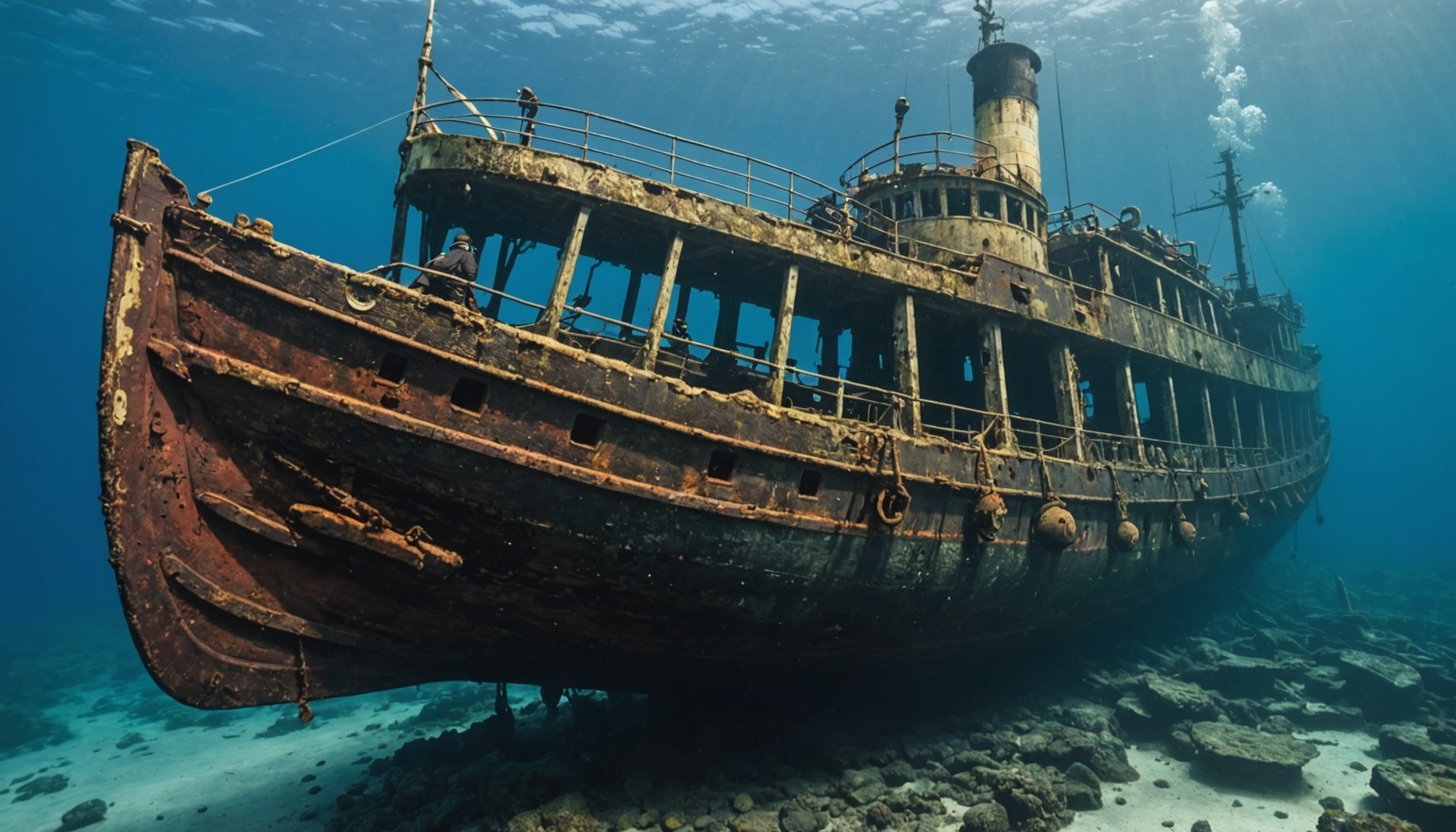Unveiling Britain’s Underwater Secrets: Your Ultimate Guide to Exploring Historic Shipwrecks on Coastal Adventures
The Allure of Britain’s Shipwrecks
Britain’s coastal waters are home to a rich and diverse array of historic shipwrecks, each with its own unique story and significance. From the tragic tale of the RMS Titanic to the sunken German High Seas Fleet in Scapa Flow, these underwater treasures offer a glimpse into the country’s maritime history and the lives of those who sailed the seas.
The Tragic Tale of the RMS Titanic
One of the most well-known shipwrecks in history is the RMS Titanic, built in Belfast and sunk on its maiden voyage in 1912 after colliding with an iceberg. This luxurious liner, meant to be unsinkable, met a tragic end, resulting in the loss of over 1,500 lives. Despite the tragedy, the Titanic remains a fascinating topic, with its grandeur and the stories of its passengers continuing to captivate people worldwide. The wreck, discovered in 1985 by Robert Ballard, is located over 12,000 feet below the surface of the Atlantic Ocean and has been the subject of numerous expeditions and research studies[1].
Also to discover : Uncover the craft of classic british basket weaving: immersive workshops tailored for travelers
Diving into History: Notable Shipwrecks in British Waters
Britain’s coastline is dotted with historic shipwrecks, each offering a unique diving experience and a window into the past.
The Wreck of La Girona
Off the coast of Northern Ireland lies the wreck of La Girona, a Spanish galleon that was part of the Spanish Armada. Sunk in 1588 during a severe storm, only a handful of the 1,300 crew and passengers survived. The wreck has been explored by divers, revealing historical and archaeological treasures from the Spanish Armada era. This site is a testament to the dangers of the sea and the bravery of those who sailed during that time[1].
Have you seen this : Explore engaging hands-on workshops in genuine british carpentry skills for travelers
The SS Gairsoppa
In the depths of the Atlantic Ocean, the SS Gairsoppa, a British cargo steamship, was sunk by a German U-boat in 1941 during World War II. Carrying over 7,000 tonnes of silver bullion, this wreck is one of the deepest ever discovered, located over three miles below the surface. The recovery of the silver bullion was a complex operation involving remotely operated vehicles (ROVs), highlighting the challenges and rewards of deep-sea salvage operations[1].
Scapa Flow: A Diver’s Paradise
Located in the Orkney Islands, Scotland, Scapa Flow is renowned for its historical significance and as a premier dive site. Here, you can explore the remnants of the German High Seas Fleet, scuttled in 1919 to prevent them from being seized by the Allies. The site also includes “blocking” ships deliberately sunk to prevent enemy access, and more recent wrecks like the James Barrie. The wrecks are not only historically significant but also teeming with marine life, making Scapa Flow a must-visit for any serious diver[2].
The Science and Technology Behind Shipwreck Exploration
The discovery and exploration of shipwrecks have advanced significantly with technological advancements.
Modern Tools and Techniques for Shipwreck Discovery
Modern equipment has revolutionized the field of underwater archaeology. Tools such as underwater robots (ROVs), sonar equipment, and 3D mapping technology enable divers to locate and explore wrecks that were previously inaccessible. ROVs, in particular, are crucial for deep-water exploration, equipped with cameras, lights, and sensors to collect data and navigate through wrecks safely[1].
Underwater Archaeology: Uncovering the Past
Underwater archaeology has become increasingly important, leading to significant discoveries that provide insights into maritime history. Divers and scientists use specialized tools like sediment corers to extract samples from the seafloor, which can reveal environmental conditions at the time of the ship’s sinking. These discoveries help reconstruct the lives of those on board and the cultural and technological context of the era[1].
Preparing for Your Dive: Safety and Equipment
Wreck diving is an exhilarating experience, but it requires careful preparation and the right equipment to ensure safety.
Essential Equipment for Wreck Diving
- Dive Computer: Crucial for monitoring dive time and depth, allowing for precise tracking and safe ascent.
- Extra Breathing Gas: A redundant gas supply is vital, especially during penetration dives, to prevent running out of air.
- Marker Buoy: Helps pinpoint your location at the surface, aiding in navigation.
- Wreck Reel or Spool: Marks your route and helps prevent disorientation during penetration dives[3].
Full Penetration Diving: Advanced Skills Required
Full penetration dives involve navigating deep into the interior of a wreck, requiring advanced skills and specialized training. This type of dive demands meticulous planning, adherence to safety protocols, and the use of specialized equipment like dive lights and redundant air supplies. It is ideal for highly experienced divers with certifications in wreck and overhead environment diving[3].
Dive Sites: Where to Explore Britain’s Underwater Treasures
Britain offers a diverse range of dive sites, each with its unique characteristics and historical significance.
Scapa Flow: A Diver’s Paradise
Scapa Flow is one of the most popular dive sites in Europe, offering a year-round diving experience. The site includes the German High Seas Fleet, “blocking” ships, and more recent wrecks. The best visibility is between December and March, although the water is cold, while the warmer months of August, September, and October can coincide with algal blooms reducing visibility[2].
North Devon: Artificial Reefs and Historic Wrecks
North Devon is home to several artificial reefs and historic wrecks, including those from World War II. These sites are known for their abundant marine life and offer a range of diving experiences from shallow to deep dives. The area is also popular for underwater photography, capturing the vibrant marine life and the historical significance of the wrecks.
Table: Comparing Notable British Dive Sites
| Dive Site | Location | Historical Significance | Depth | Visibility | Marine Life |
|---|---|---|---|---|---|
| Scapa Flow | Orkney Islands, Scotland | German High Seas Fleet, WWI & WWII wrecks | 14-18 metres | Best: Dec-Mar, Poor: Aug-Oct | Anemones, lobsters, starfish |
| SS Gairsoppa | Atlantic Ocean | British cargo steamship, WWII | Over 3 miles | Limited due to depth | Deep-sea fish |
| La Girona | Northern Ireland | Spanish Armada galleon | Varies | Good, depending on weather | Various marine species |
| HMS Whirlwind | North Sea | Royal Navy destroyer, WWII | 36 metres | Good | Fish, anemones |
Practical Insights and Actionable Advice
For those interested in exploring Britain’s underwater secrets, here are some practical insights and advice:
Planning Your Dive
- Research the Site: Understand the historical context and any specific regulations or permissions required.
- Check Weather Conditions: Ensure the weather is favorable for diving, especially in areas prone to strong currents or poor visibility.
- Join a Guided Tour: For less experienced divers, joining a guided tour can provide valuable insights and ensure safety.
Respecting the Wrecks
- Follow Local Regulations: Many wrecks are protected under laws like the Protection of Wrecks Act 1973, so ensure you have the necessary permissions.
- Do Not Disturb Artifacts: Leave the site as you found it to preserve the historical integrity of the wreck.
- Respect Marine Life: Avoid damaging the marine ecosystem that has developed around the wreck.
Quotes from Experienced Divers
- “Scapa Flow is a real beauty. The wrecks are covered in life, and the gin-clear water makes it feel like diving in a cathedral.” – Richard Rigby, Jordan[2].
- “The memory of diving the Tabarka is still fresh in my mind. It was stunning, with numerous entry points and an abundance of marine life.” – Jon Chitty, BSAC[2].
Exploring Britain’s historic shipwrecks is a journey through time, offering a unique blend of history, adventure, and marine life. Whether you are a seasoned diver or just starting out, these underwater treasures provide an unparalleled diving experience. With the right equipment, careful planning, and a deep respect for the sites, you can uncover the secrets that lie beneath Britain’s coastal waters.
As Ross Kemp, a well-known treasure hunter, once said, “The sea has a way of keeping its secrets, but with the right tools and knowledge, we can uncover them and learn from our maritime history.” So, gear up, dive in, and discover the fascinating world of Britain’s shipwrecks.











